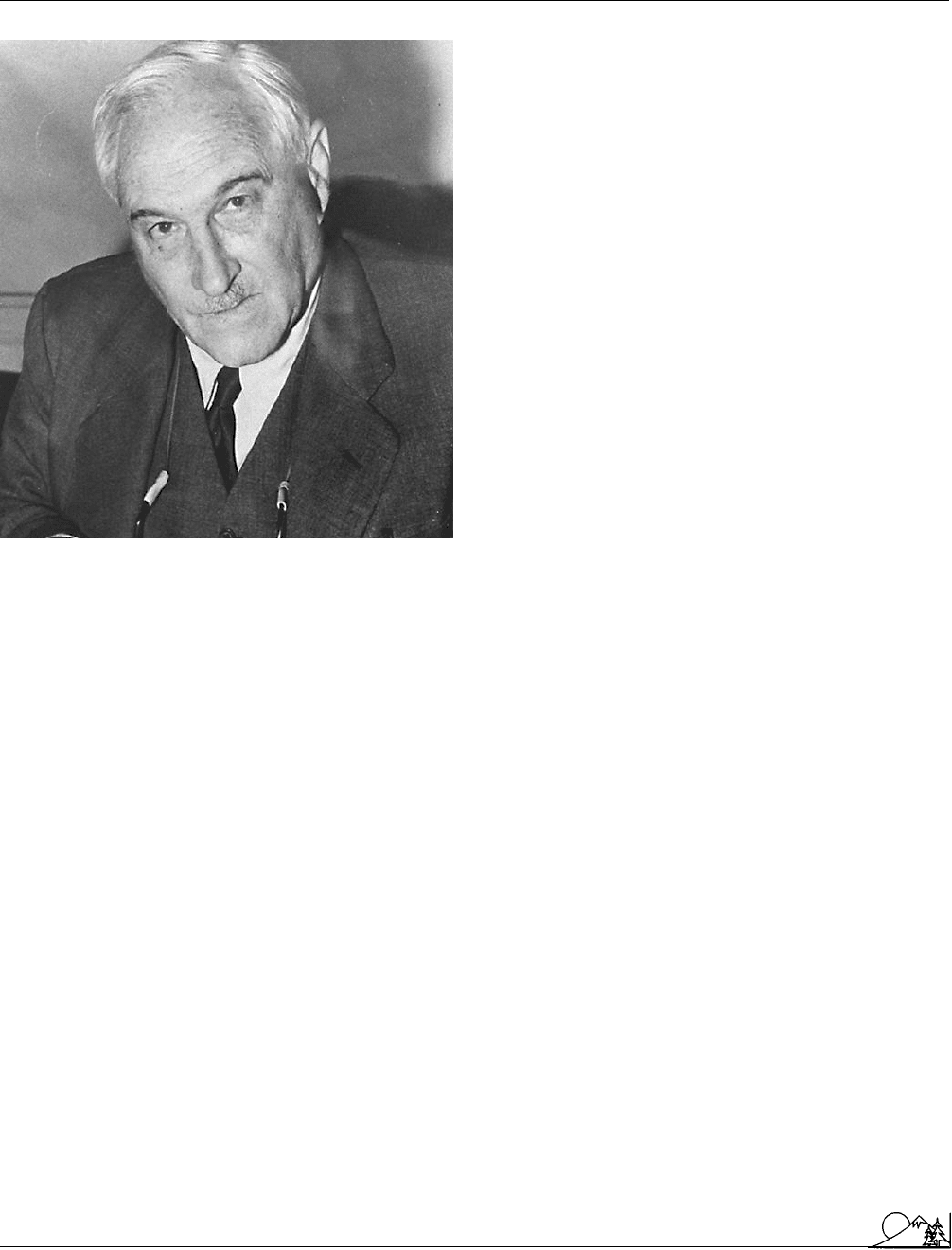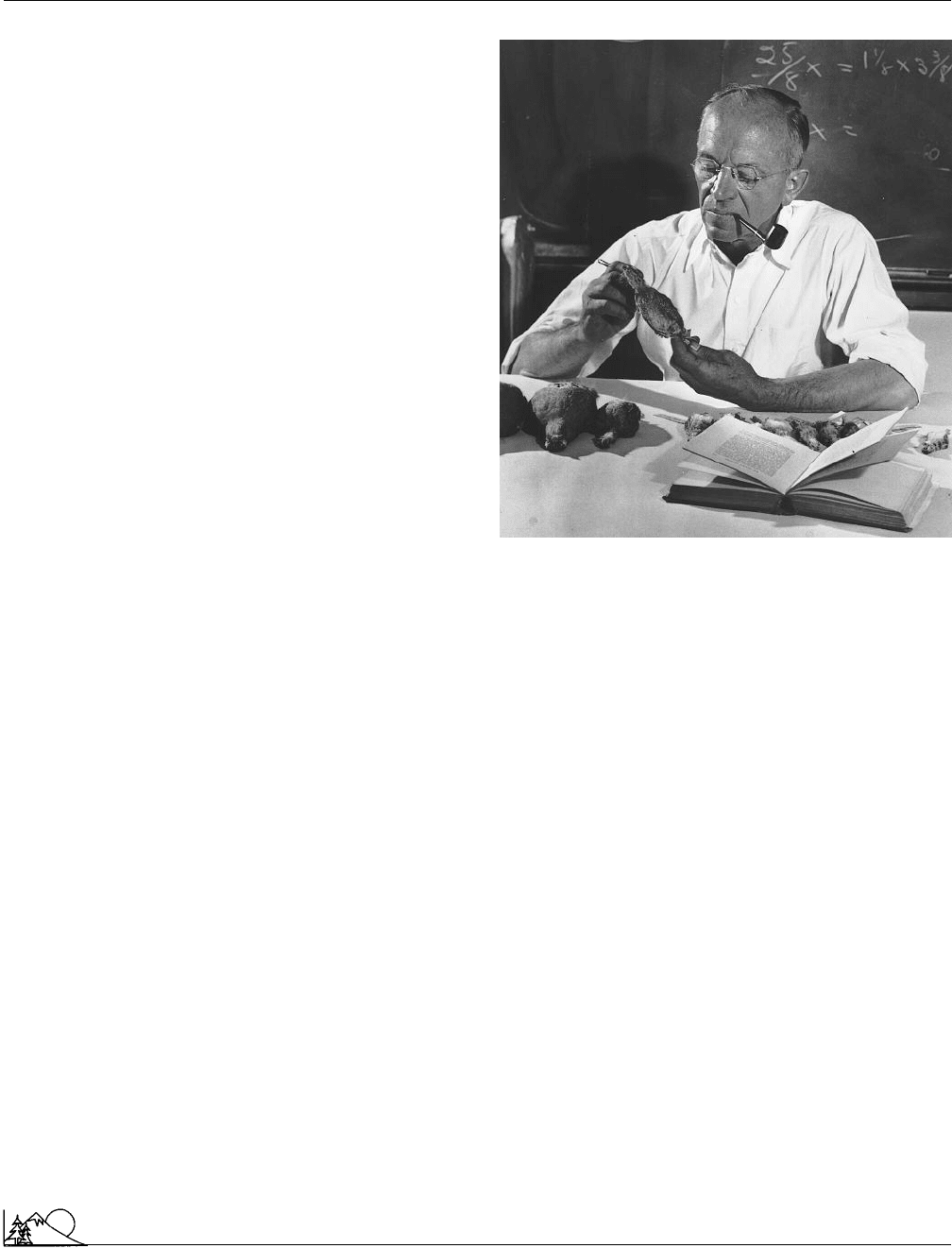Environmental Encyclopedia
Подождите немного. Документ загружается.


Environmental Encyclopedia 3
Louis Seymour Bazett Leakey
humans and was, along with an erect posture, one of the
chief characteristics used to differentiate humans from non-
humans. Scientists at the time, however, did not consider
East Africa a likely site for finding evidence of early humans;
the discovery of Pithecanthropus in Java in 1894 (the so-
called Java Man, now considered to be an example of Homo
erectus) had led scientists to assume that Asia was the conti-
nent from which human forms had spread.
Shortly after the end of World War I, Leakey was
sent to a public school in Weymouth, England, and later
attended St. John’s College, Cambridge. Suffering from se-
vere headaches resulting from a sports injury, he took a year
off from his studies and joined a fossil-hunting expedition
to Tanganyika (now Tanzania). This experience, combined
with his studies in anthropology at Cambridge (culminating
in a degree in 1926), led Leakey to devote his time to the
search for the origins of humanity, which he believed would
be found in Africa. Anatomist and anthropologist Raymond
A. Dart’s discovery of early human remains in South Africa
was the first concrete evidence that this view was correct.
Leakey’s next expedition was to northwest Kenya, near Lakes
Nakuru and Naivasha, where he uncovered materials from
the Late Stone Age; at Kariandusi he discovered a 200,000-
year-old hand ax.
In 1928 Leakey married Henrietta Wilfrida Avern,
with whom he had two children: Priscilla, born in 1930,
and Colin, born in 1933; the couple was divorced in the
mid-1930s. In 1931 Leakey made his first trip to Olduvai
Gorge—a 350-mi (564-km) ravine in Tanzania—the site
that was to be his richest source of human remains. He had
been discouraged from excavating at Olduvai by Hans Reck,
a German paleontologist who had fruitlessly sought evidence
of prehistoric humans there. Leakey’s first discoveries at
that site consisted of both animal fossils, important in the
attempts to date the particular stratum (or layer of earth) in
which they were found, and, significantly, flint tools. These
tools, dated to approximately one million years ago, were
conclusive evidence of the presence of hominids—a family
of erect primate mammals that use only two feet for locomo-
tion—in Africa at that early date; it was not until 1959,
however, that the first fossilized hominid remains were
found there.
In 1932, near Lake Victoria, Leakey found remains
of Homo sapiens (modern man), the so-called Kanjera skulls
(dated to 100,000 years ago) and Kanam jaw (dated to
500,000 years ago); Leakey’s claims for the antiquity of this
jaw made it a controversial find among other paleontologists,
and Leakey hoped he would find other, independent, evi-
dence for the existence of Homo sapiens from an even earlier
period—the Lower Pleistocene.
In the mid-1930s, a short time after his divorce from
Wilfrida, Leakey married his second wife, Mary Douglas
827
Nicol; she was to make some of the most significant discover-
ies of Leakey’s team’s research. The couple eventually had
three children: Philip, Jonathan, and Richard E. Leakey.
During the 1930s, Leakey also became interested in the
study of the Paleolithic period in Britain, both regarding
human remains and geology, and he and Mary Leakey car-
ried out excavations at Clacton in southeast England.
Until the end of the 1930s, Leakey concentrated on
the discovery of stone tools as evidence of human habitation;
after this period he devoted more time to the unearthing of
human and prehuman fossils. His expeditions to Rusinga
Island, at the mouth of the Kavirondo Gulf in Kenya, during
the 1930s and early 1940s produced a large number of finds,
especially of remains of Miocene apes. One of these apes,
which Leakey named Proconsul africanus, had a jaw lacking
in the so-called simian shelf that normally characterized the
jaws of apes; this was evidence that Proconsul represented a
stage in the progression from ancient apes to humans. In
1948 Mary Leakey found a nearly complete Proconsul skull,
the first fossil ape skull ever unearthed; this was followed
by the unearthing of several more Proconsul remains.
Louis Leakey began his first regular excavations at
Olduvai Gorge in 1952; however, the Mau Mau (an anti-
white secret society) uprising in Kenya in the early 1950s
disrupted his paleontological work and induced him to write
Mau Mau and the Kikuyu, in an effort to explain the rebellion
from the perspective of a European with an insider’s knowl-
edge of the Kikuyu. A second work, Defeating Mau Mau,
followed in 1954.
During the late 1950s, the Leakeys continued their
work at Olduvai. In 1959, while Louis was recuperating
from an illness, Mary Leakey found substantial fragments
of a hominid skull that resembled the robust australopithe-
cines—African hominids possessing small brains and near-
human dentition—found in South Africa earlier in the cen-
tury. Louis Leakey, who quickly reported the find to the
journal Nature, suggested that this represented a new genus,
which he named Zinjanthropus boisei, the genus name mean-
ing “East African man,” and the
species
name commemo-
rating Charles Boise, one of Leakey’s benefactors. This spe-
cies, now called Australopithecus boisei, was later believed by
Leakey to have been an evolutionary dead end, existing
contemporaneously with Homo rather than representing an
earlier developmental stage.
In 1961, at Fort Ternan, Leakey’s team located frag-
ments of a jaw that Leakey believed were from a hitherto
unknown genus and species of ape, one he designated as
Kenyapithecus wickeri, and which he believed was a link be-
tween ancient apes and humans, dating from 14 million
years ago; it therefore represented the earliest hominid. In
1967, however, an older skull, one that had been found two
decades earlier on Rusinga Island and which Leakey had

Environmental Encyclopedia 3
Louis Seymour Bazett Leakey
Louis Leakey. (The Library of Congress.)
originally given the name Ramapithecus africanus, was found
to have hominid-like lower dentition; he renamed it Kenya-
pithecus africanus, and Leakey believed it was an even earlier
hominid than Kenyapithecus wickeri. Leakey’s theories about
the place of these Lower Miocene fossil apes in human
evolution
have been among his most widely disputed.
During the early 1960s, a member of Leakey’s team
found fragments of the hand, foot, and leg bones of two
individuals, in a site near where Zinjanthropus had been
found, but in a slightly lower and, apparently, slightly older
layer. These bones appeared to be of a creature more like
modern humans than Zinjanthropus, possibly a species of
Homo that lived at approximately the same time, with a
larger brain and the ability to walk fully upright. As a result
of the newly developed potassium-argon dating method, it
was discovered that the bed from which these bones had
come was 1.75 million years old. The bones were, apparently,
the evidence for which Leakey had been searching for years:
skeletal remains of Homo from the Lower Pleistocene. Lea-
key designated the creature whose remains these were as
Homo habilis ("man with ability"), a creature who walked
upright and had dentition resembling that of modern hu-
mans, hands capable of toolmaking, and a large cranial capac-
ity. Leakey saw this hominid as a direct ancestor of Homo
erectus and modern humans. Not unexpectedly, Leakey was
attacked by other scholars, as this identification of the frag-
828
ments moved the origins of the genus Homo back substan-
tially further in time. Some scholars felt that the new remains
were those of australopithecines, if relatively advanced ones,
rather than very early examples of Homo.
Health problems during the 1960s curtailed Leakey’s
field work; it was at this time that his Centre for Prehistory
and Paleontology in Nairobi became the springboard for the
careers of such paleontologists as
Jane Goodall
and Dian
Fossey in the study of nonhuman primates. A request came
in 1964 from the Israeli government for assistance with the
technical as well as the fundraising aspects involved in the
excavation of an early Pleistocene site at Ubeidiya. This
produced evidence of human habitation dating back 700,000
years, the earliest such find outside Africa.
During the 1960s, others, including Mary Leakey and
the Leakeys’ son Richard, made significant finds in East
Africa; Leakey turned his attention to the investigation of
a problem that had intrigued him since his college days:
the determination of when humans had reached the North
American continent. Concentrating his investigation in the
Calico Hills in the Mojave
Desert
, California, he sought
evidence in the form of stone tools of the presence of early
humans, as he had done in East Africa. The discovery of
some pieces of chalcedony (translucent quartz) that resem-
bled manufactured tools in
sediment
dated from 50,000 to
100,000 years old stirred an immediate controversy; at that
time, scientists believed that humans had settled in North
America approximately 20,000 years ago. Many archaeolo-
gists, including Mary Leakey, criticized Leakey’s California
methodology—and his interpretations of the finds—as sci-
entifically unsound, but Leakey, still charismatic and persua-
sive, was successful in obtaining funding from the National
Geographic Society and, later, several other sources. Human
remains were not found in conjunction with the supposed
stone tools, and many scientists have not accepted these
“artifacts” as anything other than rocks.
Shortly before Louis Leakey’s death, Richard Leakey
showed his father a skull he had recently found near Lake
Rudolf (now Lake Turkana) in Kenya. This skull, removed
from a deposit dated to 2.9 million years ago, had a cranial
capacity of approximately 800 cubic centimeters, putting it
within the range of Homo and apparently vindicating Lea-
key’s long-held belief in the extreme antiquity of that genus;
it also appeared to substantiate Leakey’s interpretation of
the Kanam jaw. Leakey died of a heart attack in early Octo-
ber, 1972, in London.
Some scientists have questioned Leakey’s interpreta-
tions of his discoveries. Other scholars have pointed out that
two of the most important finds associated with him were
actually made by Mary Leakey, but became widely known
when they were interpreted and publicized by him; Leakey
had even encouraged criticism through his tendency to publi-

Environmental Encyclopedia 3
Mary Douglas Nicol Leakey
cize his somewhat sensationalistic theories before they had
been sufficiently tested. Critics have cited both his tendency
toward hyperbole and his penchant for claiming that his
finds were the “oldest,” the “first,” the “most significant"; in
a 1965 National Geographic article, for example, Melvin M.
Payne pointed out that Leakey, at a Washington, D.C.,
press conference, claimed that his discovery of Homo habilis
had made all previous scholarship on early humans obsolete.
Leakey has also been criticized for his eagerness to create
new genera and species for new finds, rather than trying to
fit them into existing categories. Leakey, however, recog-
nized the value of publicity for the fundraising efforts neces-
sary for his expeditions. He was known as an ambitious man,
with a penchant for stubbornly adhering to his interpreta-
tions, and he used the force of his personality to communi-
cate his various finds and the subsequent theories he devised
to scholars and the general public.
Leakey’s response to criticism was that scientists have
trouble divesting themselves of their own theories in the
light of new evidence. “Theories on prehistory and early
man constantly change as new evidence comes to light,”
Leakey remarked, as quoted by Payne in National Geographic.
“A single find such as Homo habilis can upset long-held—
and reluctantly discarded—concepts. A paucity of human
fossil material and the necessity for filling in blank spaces
extending through hundreds of thousands of years all con-
tribute to a divergence of interpretations. But this is all we
have to work with; we must make the best of it within the
limited range of our present knowledge and experience.”
Much of the controversy derives from the lack of consensus
among scientists about what defines “human"; to what extent
are toolmaking, dentition, cranial capacity, and an upright
posture defining characteristics, as Leakey asserted?
Louis Leakey’s significance revolves around the ways
in which he changed views of early human development.
He pushed back the date when the first humans appeared
to a time earlier than had been believed on the basis of
previous research. He showed that human evolution began
in Africa rather than Asia, as had been maintained. In addi-
tion, he created research facilities in Africa and stimulated
explorations in related fields, such as primatology (the study
of primates). His work is notable as well for the sheer number
of finds—not only of the remains of apes and humans, but
also of the plant and animal species that comprised the
ecosystems in which they lived. These finds of Leakey and
his team filled numerous gaps in scientific knowledge of the
evolution of human forms. They provided clues to the links
between prehuman, apelike primates, and early humans, and
demonstrated that human evolution may have followed more
than one parallel path, one of which led to modern humans,
rather than a single line, as earlier scientists had maintained.
[Michael Sims]
829
R
ESOURCES
B
OOKS
Cole, S. Leakey’s Luck: The Life of Louis Seymour Bazett Leakey, 1903–1972.
Harcourt, 1975.
Isaac, G., and E. R. McCown, eds., Human Origins: Louis Leakey and the
East African Evidence. Benjamin-Cummings, 1976.
Johanson, D. C., and M. A. Edey. Lucy: The Beginnings of Humankind.
Simon & Schuster, 1981.
Leakey, M. Disclosing the Past. Doubleday, 1984.
Leakey, R. One Life: An Autobiography. Salem House, 1984.
Malatesta, A., and R. Friedland, The White Kikuyu: Louis S. B. Leakey.
McGraw-Hill, 1978.
Mary Douglas Nicol Leakey (1913 –
1996)
English paleontologist and anthropologist
For many years Mary Leakey lived in the shadow of her
husband, Louis Leakey, whose reputation, coupled with the
prejudices of the time, led him to be credited with some of
his wife’s discoveries in the field of early human archaeology.
Yet she has established a substantial reputation in her own
right and has come to be recognized as one of the most
important paleoanthropologists of the twentieth century. It
was Mary Leakey who was responsible for some of the
most important discoveries made by Louis Leakey’s team.
Although her close association with Louis Leakey’s work
on Paleolithic sites at Olduvai Gorge—a 350-mi (564-km)
ravine in Tanzania—has led to her being considered a spe-
cialist in that particular area and period, she has in fact
worked on excavations dating from as early as the Miocene
Age (an era dating to approximately 18 million years ago)
to those as recent as the Iron Age of a few thousand years ago.
Mary Leakey was born Mary Douglas Nicol on Febru-
ary 6, 1913, in London. Her mother was Cecilia Frere,
the great-granddaughter of John Frere, who had discovered
prehistoric stone tools at Hoxne, Suffolk, England, in 1797.
Her father was Erskine Nicol, a painter who himself was
the son of an artist, and who had a deep interest in Egyptian
archaeology. When Mary was a child, her family made fre-
quent trips to southwestern France, where her father took
her to see the Upper Paleolithic cave paintings. She and her
father became friends with Elie Peyrony, the curator of the
local museum, and there she was exposed to the vast collec-
tion of flint tools dating from that period of human prehis-
tory. She was also allowed to accompany Peyrony on his
excavations, though the archaeological work was not con-
ducted in what would now be considered a scientific way—
artifacts were removed from the site without careful study of
the place in the earth where each had been found, obscuring
valuable data that could be used in dating the artifact and
analyzing its context. On a later trip, in 1925, she was taken

Environmental Encyclopedia 3
Mary Douglas Nicol Leakey
to Paleolithic caves by the Abbe Lemozi of France, parish
priest of Cabrerets, who had written papers on cave art.
After her father’s death in 1926, Mary Nicol was taken to
Stonehenge and Avebury in England, where she began to
learn about the archaeological activity in that country and,
after meeting the archaeologist Dorothy Liddell, to realize
the possibility of archaeology as a career for a woman.
By 1930 Mary Nicol had undertaken coursework in
geology and archaeology at the University of London and
had participated in a few excavations in order to obtain field
experience. One of her lecturers, R. E. M. Wheeler, offered
her the opportunity to join his party excavating St. Albans,
England, the ancient Roman site of Verulamium; although
she only remained at that site for a few days, finding the
work there poorly organized, she began her career in earnest
shortly thereafter, excavating Neolithic (early Stone Age)
sites in Henbury, Devon, where she worked between 1930
and 1934. Her main area of expertise was stone tools, and
she was exceptionally skilled at making drawings of them.
During the 1930s Mary met Louis Leakey, who was to
become her husband. Leakey was by this time well known
because of his finds of early human remains in East Africa;
it was at Mary and Louis’s first meeting that he asked her
to help him with the illustrations for his 1934 book, Adam’s
Ancestors: An Up-to-Date Outline of What Is Known about
the Origin of Man.
In 1934 Mary Nicol and Louis Leakey worked at
an excavation in Clacton, England, where the skull of a
hominid—a family of erect primate mammals that use only
two feet for locomotion—had recently been found and where
Louis was investigating Paleolithic geology as well as
fauna
and human remains. The excavation led to Mary Leakey’s
first publication, a 1937 report in the Proceedings of the Prehis-
toric Society.
By this time, Louis Leakey had decided that Mary
should join him on his next expedition to Olduvai Gorge
in Tanganyika (now Tanzania), which he believed to be the
most promising site for discovering early Paleolithic human
remains. On the journey to Olduvai, Mary stopped briefly
in South Africa, where she spent a few weeks with an archae-
ological team and learned more about the scientific approach
to excavation, studying each find in situ—paying close atten-
tion to the details of the geological and faunal material
surrounding each artifact. This knowledge was to assist her
in her later work at Olduvai and elsewhere.
At Olduvai, among her earliest discoveries were frag-
ments of a human skull; these were some of the first such
remains found at the site, and it would be twenty years
before any others would be found there. Mary Nicol and
Louis Leakey returned to England. Leakey’s divorce from
his first wife was made final in the mid-1930s, and he and
Mary Nicol were then married; the couple returned to Kenya
830
in January of 1937. Over the next few years, the Leakeys
excavated Neolithic and Iron Age sites at Hyrax Hill, Njoro
River Cave, and the Naivasha Railway Rock Shelter, which
yielded a large number of human remains and artifacts.
During World War II, the Leakeys began to excavate
at Olorgasailie, southwest of Nairobi, but because of the
complicated geology of that site, the dating of material found
there was difficult. It did prove to be a rich source of material,
however; in 1942 Mary Leakey uncovered hundreds, possibly
thousands, of hand axes there. Her first major discovery in
the field of prehuman fossils was that of most of the skull
of a Proconsul africanus on Rusinga Island, in Lake Victoria,
Kenya, in 1948. Proconsul was believed by some paleontolo-
gists to be a common ancestor of apes and humans, an
animal whose descendants developed into two branches on
the evolutionary tree: the Pongidae (great apes) and the Hom-
inidae (who eventually evolved into true humans). Proconsul
lived during the Miocene Age, approximately 18 million
years ago. This was the first time a fossil ape skull had ever
been found—only a small number have been found since—
and the Leakeys hoped that this would be the ancestral
hominid that paleontologists had sought for decades. The
absence of a “simian shelf,” a reinforcement of the jaw found
in modern apes, is one of the features of Proconsul that led
the Leakeys to infer that this was a direct ancestor of modern
humans. Proconsul is now generally believed to be a
species
of Dryopithecus, closer to apes than to humans.
Many of the finds at Olduvai were primitive stone
hand axes, evidence of human habitation; it was not known,
however, who had made them. Mary’s concentration had
been on the discovery of such tools, while Louis’s goal had
been to learn who had made them, in the hope that the date
for the appearance of toolmaking hominids could be moved
back to an earlier point. In 1959 Mary unearthed part of
the jaw of an early hominid she designated Zinjanthropus
(meaning “East African Man") and whom she referred to
as “Dear Boy"; the early hominid is now considered to be
a species of Australopithecus—apparently related to the two
kinds of australopithecine found in South Africa, Australopi-
thecus africanus and Australopithecus robustus— and given the
species designation boisei in honor of Louis Leakey’s sponsor
Charles Boise. By means of potassium-argon dating, recently
developed, it was determined that the fragment was 1.75
million years old, and this realization pushed back the date
for the appearance of hominids in Africa. Despite the impor-
tance of this find, however, Louis Leakey was slightly disap-
pointed, as he had hoped that the excavations would unearth
not another australopithecine, but an example of Homo living
at that early date. He was seeking evidence for his theory
that more than one hominid form lived at Olduvai at the
same time; these forms were the australopithecines, who
eventually died out, and some early form of Homo, which

Environmental Encyclopedia 3
Richard Erskine Frere Leakey
survived—owing to toolmaking ability and larger cranial
capacity—to evolve into Homo erectus and, eventually, the
modern human. Leakey hoped that Mary Leakey’s find
would prove that Homo existed at that early level of Olduvai.
The discovery he awaited did not come until the early 1960s,
with the identification of a skull found by their son Jonathan
Leakey that Louis designated as Homohabilis ("man with
ability"). He believed this to be the true early human respon-
sible for making the tools found at the site.
In her autobiography, Disclosing the Past, released in
1984, Mary Leakey reveals that her professional and personal
relationship with Louis Leakey had begun to deteriorate by
1968. As she increasingly began to lead the Olduvai research
on her own, and as she developed a reputation in her own
right through her numerous publications of research results,
she believes that her husband began to feel threatened. Louis
Leakey had been spending a vast amount of his time in
fundraising and administrative matters, while Mary was able
to concentrate on field work. As Louis began to seek recogni-
tion in new areas, most notably in excavations seeking evi-
dence of early humans in California, Mary stepped up her
work at Olduvai, and the breach between them widened.
She became critical of his interpretations of his California
finds, viewing them as evidence of a decline in his scientific
rigor. During these years at Olduvai, Mary made numerous
new discoveries, including the first Homo erectus pelvis to be
found. Mary Leakey continued her work after Louis Leakey’s
death in 1972. From 1975 she concentrated on Laetoli,
Tanzania, which was a site earlier than the oldest beds at
Olduvai. She knew that the lava above the Laetoli beds was
dated to 2.4 million years ago, and the beds themselves were
therefore even older; in contrast, the oldest beds at Olduvai
were two million years old. Potassium-argon dating has since
shown the upper beds at Laetoli to be approximately 3.5
million years old. In 1978 members of her team found two
trails of hominid footprints in volcanic ash dated to approxi-
mately 3.5 million years ago; the form of the footprints gave
evidence that these hominids walked upright, thus moving
the date for the development of an upright posture back
significantly earlier than previously believed. Mary Leakey
considers these footprints to be among the most significant
finds with which she has been associated.
In the late 1960s Mary Leakey received an honorary
doctorate from the University of the Witwatersrand in South
Africa, an honor she accepted only after university officials
had spoken out against apartheid. Among her other honorary
degrees are a D.S.Sc. from Yale University and a D.Sc. from
the University of Chicago. She received an honorary D.Litt.
from Oxford University in 1981. She has also received the
Gold Medal of the Society of Women Geographers.
Louis Leakey was sometimes faulted for being too
quick to interpret the finds of his team and for his propensity
831
for developing sensationalistic, publicity-attracting theories.
In recent years Mary Leakey had been critical of the conclu-
sions reached by her husband—as well as by some others—
but she did not add her own interpretations to the mix.
Instead, she has always been more concerned with the act
of discovery itself; she wrote that it is more important for
her to continue the task of uncovering early human remains
to provide the pieces of the puzzle than it is to speculate
and develop her own interpretations. Her legacy lies in the
vast amount of material she and her team have unearthed;
she leaves it to future scholars to deduce its meaning.
[Michael Sims]
R
ESOURCES
B
OOKS
Isaac, G., and E. R. McCown, eds. Human Origins: Louis Leakey and the
East African Evidence. Benjamin-Cummings, 1976.
Reader, J. Missing Links. Little, Brown, 1981.
Moore, R. E., Man, Time, and Fossils: The Story of Evolution. Knopf, 1961.
Malatesta, A., and R. Friedland, The White Kikuyu: Louis S. B. Leakey.
McGraw-Hill, 1978.
Leakey, R. One Life: An Autobiography. Salem House, 1984.
Johanson, D. C., and M. A. Edey, Lucy: The Beginnings of Humankind.
Simon & Schuster, 1981.
Cole, S. Leakey’s Luck: The Life of Louis Seymour Bazett Leakey, 1903–1972.
Harcourt, 1975.
Leakey, L. By the Evidence: Memoirs, 1932–1951. Harcourt, 1974.
Richard Erskine Frere Leakey (1944 – )
African-born English paleontologist and anthropologist
Richard Erskine Frere Leakey was born on December 19,
1944, in Nairobi, Kenya. Continuing the work of his parents,
Leakey has pushed the date for the appearance of the first
true humans back even further than they had, to nearly three
million years ago. This represents nearly a doubling of the
previous estimates. Leakey also has found more evidence to
support his father’s still controversial theory that there were
at least two parallel branches of human
evolution
, of which
only one was successful. The abundance of human fossils
uncovered by Richard Leakey’s team has provided an enor-
mous number of clues as to how the various fossil remains
fit into the puzzle of human evolution. The team’s finds
have also helped to answer, if only speculatively, some basic
questions: When did modern human’s ancestors split off
from the ancient apes? On what continent did this take
place? At what point did they develop the characteristics
now considered as defining human attributes? What is the
relationship among and the chronology of the various genera
and
species
of the fossil remains that have been found?

Environmental Encyclopedia 3
Richard Erskine Frere Leakey
While accompanying his parents on an excavation at
Kanjera near Lake Victoria at the age of six, Richard Leakey
made his first discovery of fossilized animal remains, part
of an extinct variety of giant pig. Richard Leakey, however,
was determined not to “ride upon his parents’ shoulders,”
as Mary Leakey wrote in her autobiography, Disclosing the
Past. Several years later, as a young teenager in the early
1960s, Richard demonstrated a talent for
trapping wildlife
,
which prompted him to drop out of high school to lead
photographic safaris in Kenya. His paleontological career
began in 1963, when he led a team of paleontologists to a
fossil-bearing area near Lake Natron in Tanganyika (now
Tanzania), a site that was later dated to approximately 1.4
million years ago. A member of the team discovered the jaw
of an early hominid—a member of the family of erect primate
mammals that use only two feet for locomotion—called an
Australopithecus boisei (then named Zinjanthropus).) This was
the first discovery of a complete Australopithecus lower jaw
and the only Australopithecus skull fragment found since
Mary Leakey’s landmark discovery in 1959. Jaws provide
essential clues about the nature of a hominid, both in terms
of its structural similarity to other species and, if teeth are
present, its diet. Richard Leakey spent the next few years
occupied with more excavations, the most important result of
which was the discovery of a nearly complete fossil elephant.
In 1964 Richard married Margaret Cropper, who had
been a member of his father’s team at Olduvai the year
before. It was at this time that he became associated with
his father’s Centre for Prehistory and Paleontology in Nai-
robi. In 1968, at the age of 23, he became administrative
director of the National Museum of Kenya.
While his parents had mined with great success the
fossil-rich Olduvai Gorge, Richard Leakey concentrated his
efforts in northern Kenya and southern Ethiopia. In 1967
he served as the leader of an expedition to the Omo Delta
area of southern Ethiopia, a trip financed by the National
Geographic Society. In a site dated to approximately 150,000
years ago, members of his team located portions of two
fossilized human skulls believed to be from examples of
Homo sapiens, or modern humans. While the prevailing view
at the time was that Homo sapiens emerged around 60,000
years ago, these skulls were dated at 130,000 years old.
While on an airplane trip, Richard Leakey flew over
the eastern portion of Lake Rudolf (now Lake Turkana) on
the Ethiopia-Kenya border, and he noticed from the air
what appeared to be ancient lake sediments, a kind of terrain
that he felt looked promising as an excavation site. He used
his next National Geographic Society grant to explore this
area. The region was Koobi Fora, a site that was to become
Richard Leakey’s most important area for excavation. At
Koobi Fora his team uncovered more than four hundred
hominid fossils and an abundance of stone tools, such tools
832
being a primary indication of the presence of early humans.
Subsequent excavations near the Omo River in Kenya, from
1968, unearthed more examples of early humans, the first
found being another Australopithecus lower jaw fragment. At
the area of Koobi Fora known as the KBS tuff (tuff being
volcanic ash; KBS standing for the Kay Behrensmeyer Site,
after a member of the team) stone tools were found. Prelimi-
nary dating of the site placed the area at 2.6 million years ago;
subsequent tests over the following few years determined the
now generally accepted age of 1.89 million years.
In July of 1969, Richard Leakey came across a virtually
complete Australopithecus boisei skull—lacking only the teeth
and lower jaw—lying in a river bed. A few days later a
member of the team located another hominid skull nearby,
comprising the back and base of the cranium. The following
year brought the discovery of many more fossil hominid
remains, at the rate of nearly two per week. Among the
most important finds was the first hominid femur to be
found in Kenya, which was soon followed by several more.
It was at about this time that Leakey obtained a divorce
from his first wife, and in October of 1970, he married
Meave Gillian Epps, who had been on the 1969 expedition.
In 1972, Richard Leakey’s team uncovered a skull that
appeared to be similar to the one identified by his father
and called Homo habilis ("man with ability"). This was the
early human that Louis Leakey maintained had achieved
the toolmaking skills that precipitated the development of
a larger brain capacity and led to the development of the
modern human—Homo sapiens. This skull was more com-
plete and apparently somewhat older than the one Louis
Leakey had found and was thus the earliest example of the
species Homo yet discovered. They labeled the new skull,
which was found below the KBS tuff, “Skull 1470,” and
this proved to among Richard Leakey’s most significant
discoveries. The fragments consisted of small pieces of all
sides of the cranium, and, unusually, the facial bones, enough
to permit a reasonably complete reconstruction. Larger than
the skulls found in 1969 and 1970, this example had approxi-
mately twice the cranial capacity of Australopithecus and more
than half that of a modern human—nearly 800 cubic centi-
meters. At the time, Leakey believed the fragments to be
2.9 million years old (although a more recent dating of the
site would place them at less than 2 million years old). Basing
his theory in part on these data, Leakey developed the view
that these early hominids may have lived as early as 2.5 or
even 3.5 million years ago and gave evidence to the theory
that Homo habilis was not a descendant of the australopithe-
cines, but a contemporary.
By the late 1960s, relations between Richard Leakey
and his father had become strained, partly because of real
or imagined competition within the administrative structure
of the Centre for Prehistory, and partly because of some

Environmental Encyclopedia 3
Leaking underground storage tank
divergences in methodology and interpretation. Shortly be-
fore Louis Leakey’s death, however, the discovery of Skull
1470 by Richard Leakey’s team allowed Richard to present
his father with apparent corroboration of one of his central
theories.
Richard Leakey did not make his theories of human
evolution public until 1974. At this time, scientists were still
grappling with Louis Leakey’s interpretation of his findings
that there had been at least two parallel lines of human
evolution, only one of which led to modern humans. After
Louis Leakey’s death, Richard Leakey reported that, based
on new finds, he believed that hominids diversified between
3 and 3.5 million years ago. Various lines of australopithe-
cines and Homo coexisted, with only one line, Homo, surviv-
ing. The australopithecines and Homo shared a common
ancestor; Australopithecus was not ancestral to Homo. As did
his father, Leakey believes that Homo developed in Africa,
and it was Homo erectus who, approximately 1.5 million years
ago, developed the technological capacity to begin the spread
of humans beyond their African origins. In Richard Leakey’s
scheme, Homo habilis developed into Homo erectus, who in
turn developed into Homo sapiens, the present-day human.
As new finds are made, new questions arise. Are newly
discovered variants proof of a plurality of species, or do they
give evidence of greater variety within the species that have
already been identified? To what extent is sexual dimorphism
responsible for the apparent differences in the fossils? In
some scientific circles, the discovery of fossil remains at
Hadar in Ethiopia by archaeologist Donald Carl Johanson
and others, along with the more recent revised dating of
Skull 1470, cast some doubt on Leakey’s theory in general
and on his interpretation of Homo habilis in particular. Johan-
son believed that the fossils he found at Hadar and the fossils
Mary Leakey found at Laetoli in Tanzania, and which she
classified as Homo habilis, were actually all australopithecines;
he termed them Australopithecus afarensis and claimed that
this species is the common ancestor of both the later australo-
pithecines and Homo. Richard Leakey has rejected this argu-
ment, contending that the australopithecines were not ances-
tral to Homo and that an earlier common ancestor would be
found, possibly among the fossils found by Mary Leakey at
Laetoli.
The year 1975 brought another significant find by
Leakey’s team at Koobi Fora: the team found what was
apparently the skull of a Homo erectus, according to Louis
Leakey’s theory a descendent of Homo habilis and probably
dating to 1.5 million years ago. This skull, labeled “3733,”
represents the earliest known evidence for Homo erectus in
Africa.
Richard Leakey began to suffer from health problems
during the 1970s, and in 1979 he was diagnosed with a
serious kidney malfunction. Later that year he underwent a
833
kidney transplant operation, his younger brother Philip being
the donor. During his recuperation Richard completed his
autobiography, One Life, which was released in 1984, and
following his recovery, he renewed his search for the origins
of the human species. The summer of 1984 brought another
major discovery: the so-called Turkana boy, a nearly com-
plete skeleton of a Homo erectus, missing little but the hands
and feet, and offering, for the first time, the opportunity to
view many bones of this species. It was shortly after the
unearthing of Turkana boy—whose skeletal remains indicate
that he was a twelve-year-old youngster who stood approxi-
mately five-and-a-half feet tall—that the puzzle of human
evolution became even more complicated. The discovery of
a new skull, called the Black Skull, with an Australopithecus
boisei face but a cranium that was quite apelike, introduced
yet another complication, possibly a fourth branch in the
evolutionary tree. Leakey became the Director of the Wild-
life
Conservation
and Management Department for Kenya
(Kenya Wildlife Service) in 1989 and in 1999 became head
of the Kenyan civil service.
[Michael Sims]
R
ESOURCES
B
OOKS
Leakey, M. Disclosing the Past: An Autobiography. Doubleday, 1984.
Leakey, R., and R. Lewin. Origins Reconsidered: In Search of What Makes
Us Human. Doubleday, 1992.
Reader, J. Missing Links. Little, Brown, 1981.
Leaking underground storage tank
Leaking underground storage tanks (LUST) that hold toxic
substances have come under new regulatory scrutiny in the
United States because of the health and environmental haz-
ards posed by the materials that can leak from them. These
storage tanks typically hold
petroleum
products and other
toxic
chemicals
beneath gas stations and other petroleum
facilities. An estimated 63,000 of the nation’s underground
storage tanks have been shown to leak contaminants into
the
environment
or are considered to have the potential to
leak at any time. One reason for the instability of under-
ground storage tanks is their construction. Only five percent
of underground storage tanks are made of corrosion-pro-
tected steel, while 84 percent are made of bare steel, which
corrodes easily. Another 11 percent of underground storage
tanks are made of fiberglass.
Hazardous materials seeping from some of the nation’s
six million LUSTs can contaminate aquifers, the water-
bearing rock units that supply much of the earth’s drinking
water. An
aquifer
, once contaminated, can be ruined as a
source of fresh water. In particular,
benzene
has been found

Environmental Encyclopedia 3
Aldo Leopold
to be a contaminant of
groundwater
as a result of leaks
from underground
gasoline
storage tanks. Benzene and
other volatile organic compounds have been detected in bot-
tled water despite manufacturers’ claims of purity.
According to the
Environmental Protection Agency
(EPA), more than 30 states reported groundwater contami-
nation from petroleum products leaking from underground
storage tanks. States also reported water contamination from
radioactive waste leaching
from storage containment
facilities. Other reported
pollution
problems include leaking
hazardous substances that are corrosive, explosive, readily
flammable, or chemically reactive. While
water pollution
may be the most visible consequence of leaks from under-
ground storage tanks, fires and explosions are dangerous and
sometimes real possibilities in some areas.
The EPA is charged with exploring, developing, and
disseminating technologies and funding mechanisms for
cleanup. The primary job itself, however, is left to state and
local governments. Actual cleanup is sometimes funded by
the Leaking Underground Storage Tank trust fund estab-
lished by Congress in 1986. Under the Superfund Amend-
ment and Reauthorization Act, owners and operators of
underground storage tanks are required to take corrective
action to prevent leakage. See also Comprehensive Environ-
mental Response, Compensation and Liability Act; Ground-
water monitoring; Groundwater pollution; Storage and
transport of hazardous materials; Toxic Substances Con-
trol Act
[Linda Rehkopf]
R
ESOURCES
B
OOKS
Epstein, L., and K. Stein. Leaking Underground Storage Tanks—Citizen
Action: An Ounce of Prevention. New York: Environmental Information
Exchange (Environmental Defense Fund), 1990.
P
ERIODICALS
Breen, B. “A Mountain and a Mission.” Garbage 4 (May-June 1992): 52–57.
Hoffman, R. D. R. “Stopping the Peril of Leaking Tanks.” Popular Science
238 (March 1991): 77–80.
O
THER
U.S. Environmental Protection Agency. Office of Underground Storage Tanks
(OUST). June 13, 2002 [June 21, 2002]. <http://www.epa.gov/swerust1>.
Aldo Leopold (1886 – 1978)
American conservationist, ecologist, and writer
Leopold was a noted forester, game manager, conservation-
ist, college professor, and ecologist. Yet he is known world-
wide for A Sand County Almanac, a little book considered
an important, influential work to
conservation
movement
834
of the twentieth century. In it, Leopold established the
land
ethic
, guidelines for respecting the land and preserving its
integrity. Leopold grew up in Iowa, in a house overlooking
the Mississippi River, where he learned
hunting
from his
father and an appreciation of
nature
from his mother. He
received a master’s degree in forestry from Yale and spent his
formative professional years working for the United States
Forest Service
in the American Southwest.
In the Southwest, Leopold began slowly to consider
preservation as a supplement to Gifford Pinchot’s “conserva-
tion as wise use—greatest good for the greatest number”
land management philosophy that he learned at Yale and
in the Forest Service. He began to formulate arguments
for the preservation of
wilderness
and the
sustainable
development
of wild game. Formerly a hunter who encour-
aged the elimination of predators to save the “good” animals
for hunters, Leopold became a conservationist who remem-
bered with sadness the “dying fire” in the eyes of a wolf he
had killed. In the Journal of Forestry, he began to speculate
that perhaps Pinchot’s principle of highest use itself de-
manded “that representative portions of some forests be
preserved as wilderness.”
Leopold must be recognized as one of a handful of
originators of the wilderness idea in American conservation
history. He was instrumental in the founding of the
Wilder-
ness Society
in 1935, which he described in the first issue
of Living Wilderness as “one of the focal points of a new
attitude—an intelligent humility toward man’s place in na-
ture.” In a 1941 issue of that same journal, he asserted that
wilderness also has critical practical uses “as a base-datum
of normality, a picture of how healthy land maintains itself,”
and that wilderness was needed as a living “land laboratory.”
This thinking led to the first large area designated as
wilderness in the United States. In 1924, some 574,000 acres
(232,000 ha) of the Gila
National Forest
in New Mexico
was officially named a wilderness area. Four years before,
the much smaller Trappers Lake valley in Colorado was the
first area designated “to be kept roadless and undeveloped.”
Aldo Leopold is also widely acknowledged as the
founder of
wildlife management
in the United States. His
classic text on the subject, Game Management (1933), is still
in print and widely read. Leopold tried to write a general
management framework, drawing upon and synthesizing
species
monographs and local manuals. “Details apply to
game alone, but the principles are of general import to all
fields of conservation,” he wrote. He wanted to coordinate
“science and use” in his book and felt strongly that land
managers could either try to apply such principles, or be
reduced to “hunting rabbits.” Here can be found early uses
of concepts still central to conservation and management,
such as limiting factor,
niche
, saturation point, and
carrying
capacity
. Leopold later became the first professor of game

Environmental Encyclopedia 3
Aldo Leopold
management in the United States at the University of Wis-
consin.
Leopold’s A Sand County Almanac, published in 1949,
a year after his death, is often described as “the bible of the
environmental movement” of the second half of the twenti-
eth century. The Almanac is a beautifully written source
of solid ecological concepts such as trophic linkages and
biological community
. The book extends basic ecological
concepts, forming radical ideas to reformulate human think-
ing and behavior. It exhibits an ecological conscience, a
conservation aesthetic, and a land ethic. He advocated his
concept of ecological conscience to fill in a perceived gap
in conservation education: “Obligations have no meaning
without conscience, and the problem we face is the extension
of the social conscience from people to land.” Lesser known
is his attention to the aesthetics of land: according to the
Almanac, an acceptable land aesthetic emerges only from
learned and sensitive perception of the connections and
needs of natural communities. The last words in the Almanac
are that a true conservation aesthetic is developed “not of
building roads into lovely country, but of building receptivity
into the still unlovely human mind.”
Leopold derived his now famous land ethic from an
ecological conception of community. All ethics, he main-
tained, “rest upon a single premise: that the individual is a
member of a community of interdependent parts.” He argued
that “the land ethic simply enlarges the boundaries of the
community to include soils, waters, plants, and animals,
or collectively: the land.” Perhaps the most widely quoted
statement from the book argues that “a thing is right when
it tends to preserve the integrity,
stability
, and beauty of
the
biotic community
. It is wrong when it tends otherwise.”
Leopold’s land ethic was first proposed in the Journal
of Forestry article in 1933 and later expanded in the Almanac.
It is a plea to care for land and its biological complex, instead
of considering it a commodity. As Wallace Tegner noted,
Leopold’s ideas were heretical in 1949, and to some people
still are. “They smack of socialism and the public good,” he
wrote. “They impose limits and restraints. They are anti-
Progress. They dampen American initiative. They fly in the
face of the faith that land is a commodity, the very foundation
stone of American opportunity.” As a result, Stegner and
others do not think Leopold’s ethic had much influence
on public thought, though the book has been widely read.
Leopold recognized this. “The case for a land ethic would
appear hopeless but for the minority which is in obvious
revolt against these ’modern’ trends,” he commented. Never-
theless, the land ethic is alive and still flourishing, in an
ever-growing minority. Even Stegner argued that “Leopold’s
land ethic is not a fact but [an on-going] task.” Leopold did
not shrink from that task, being actively involved in many
835
Aldo Leopold examining a gray partridge. (Pho-
tograph by Robert Oetking. University of Wisconsin-Madi-
son Archives. Reproduced by permission.)
conservation associations, teaching management principles
and the land ethic to his classes, bringing up all five of his
children to become conservationists, and applying his beliefs
directly to his own land, a parcel of “logged, fire-swept,
overgrazed, barren” land in Sauk County, Wisconsin. As his
work has become more recognized and more influential,
many labels have been applied to Leopold by contemporary
writers. He is a “prophet” and “intellectual touchstone” to
Roderick Nash a “founding genius” to J. Baird Callicott
“an American Isaiah” to Stegner the “Moses of the new
conservation impulse” to Donald Fleming. In a sense, he
may have been all of these, but more than anything else,
Leopold was an applied ecologist who tried to put into
practice the principles he learned from the land.
[Gerald R. Young Ph.D.]
R
ESOURCES
B
OOKS
Callicott, J. B., ed. Companion to A Sand County Almanac: Interpretive and
Critical Essays. Madison: University of Wisconsin Press, 1987.
Flader, S. L., and J. B. Callicott, eds. The River of the Mother of God and
Other Essays by Aldo Leopold. Madison: University of Wisconsin Press, 1991.

Environmental Encyclopedia 3
Less developed countries
Fritzell, P. A. “A Sand County Almanac and The Conflicts of Ecological
Conscience.” In Nature Writing and America: Essays Upon a Cultural Type.
Ames: Iowa State University Press, 1990.
Leopold, A. Game Management. New York: Charles Scribner’s Sons, 1933.
———. A Sand County Almanac. New York: Oxford University Press, 1949.
Meine, C. Aldo Leopold: His Life and Work. Madison: University of Wiscon-
sin Press, 1988.
Oelschlaeger, M. “Aldo Leopold and the Age of Ecology.” In The Idea of
Wilderness: From Prehistory to the Age of Ecology. New Haven, CT: Yale
University Press, 1991.
Strong, D. H. “Aldo Leopold.” In Dreamers and Defenders: American Conser-
vationists. Lincoln: University of Nebraska Press, 1988.
Less developed countries
Less developed countries (LDCs) have lower levels of eco-
nomic prosperity, health care, and education than most other
countries. Development or improvement in economic and
social conditions encompasses various aspects of general wel-
fare, including infant survival, expected life span, nutrition,
literacy rates, employment, and access to material goods.
Less developed countries (LDCs) are identified by their
relatively poor ratings in these categories. In addition, most
LDCs are marked by high
population growth
, rapidly
expanding cities, low levels of technological development,
and weak economies dominated by agriculture and the export
of
natural resources
. Because of their limited economic
and technological development, LDCs tend to have rela-
tively little international political power compared to more
developed countries (MDC) such as Japan, the United
States, and Germany.
A variety of standard measures, or development indi-
ces, are used to assess development stages. These indices are
generalized statistical measures of quality of life for individu-
als in a society. Multiple indices are usually considered more
accurate than a single number such as Gross National Prod-
uct, because such figures tend to give imprecise and simplistic
impressions of conditions in a country. One of the most
important of the multiple indices is the infant
mortality
rate.
Because children under five years old are highly susceptible to
common diseases, especially when they are malnourished,
infant mortality is a key to assessing both nutrition and
access to health care. Expected life span, the average age
adults are able to reach, is used as a measure of adult health.
Daily calorie and protein intake per person are collective
measures that reflect the ability of individuals to grow and
function effectively. Literacy rates, especially among women,
who are normally the last to receive an education, indicate
access to schools and preparation for technologically ad-
vanced employment.
Fertility rates are a measure of the number of children
produced per family or per woman in a population and are
regarded as an important measure of the confidence parents
836
have in their childrens’ survival. High birth rates are associ-
ated with unstable social conditions because a country with
a rapidly growing population often cannot provide its citizens
with food, water,
sanitation
, housing space, jobs, and other
basic needs. Rapidly growing populations also tend to un-
dergo rapid urbanization. People move to cities in search of
jobs and educational opportunities, but in poor countries
the cost of providing basic infrastructure in an expanding
city can be debilitating. As most countries develop, they pass
from a stage of high birth rates to one of low birth rates, as
child survival becomes more certain and a family’s investment
in educating and providing for each child increases.
Most LDCs were colonies under foreign control dur-
ing the past 200 years. Colonial powers tended to undermine
social organization, local economies, and natural resource
bases, and many recently independent states are still recov-
ering from this legacy. Thus, much of Africa, which provided
a wealth of natural resources to Europe between the seven-
teenth and twentieth centuries, now lacks the effective and
equitable social organization necessary for continuing devel-
opment. Similarly, much of Central America (colonized by
Spain in the fifteenth century) and portions of South and
Southeast Asia (colonized by England, France, the Nether-
lands, and others) remain less developed despite their wealth
of natural resources. The development processes necessary
to improve standards of living in LDCs may involve more
natural resource extraction, but usually the most important
steps involve carefully choosing the goods to be produced,
decreasing corruption among government and business lead-
ers, and easing the social unrest and conflicts that prevent
development from proceeding. All of these are extraordi-
narily difficult to do, but they are essential for countries
trying to escape from poverty. See also Child survival revolu-
tion; Debt for nature swap; Economic growth and the envi-
ronment; Indigenous peoples; Shanty towns; South; Sustain-
able development; Third World; Third World pollution;
Tropical rain forest; World Bank
[Muthena Naseri]
R
ESOURCES
B
OOKS
Gill, S., and D. Law. The Global Political Economy. Baltimore: Johns Hop-
kins University Press, 1991.
World Bank. World Development Report: Development and the Environment.
Oxford, England: Oxford University Press, 1992.
World Bank. World Development Report 2000/2001: Attacking Poverty. Ox-
ford, England: Oxford University Press, 2000.
Leukemia
Leukemia is a disease of the blood-forming organs. Primary
tumors are found in the bone marrow and lymphoid tissues,
